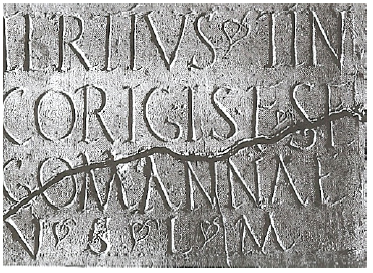b) Segomanna (‘Victory Giver’)
The goddess Segeta is etymologically linked to another goddess named Segomanna, mentioned in a single inscription, discovered in 1905, in the middle of the ruins of huts, when excavations were carried out at the site of the oppidum* of Labaume, situated on the plateau du ‘Bois de Labaume’, which overhangs the small gorges of the River Seynes and the plain of Serviers-et-Labaume (Gard), in the territory of the Volcae Arecomici.1603 The archaeological artefacts collected on the oppidum* attest to an important occupation in the second period of the Iron Age. The site was then abandoned before the Roman conquest.1604 The inscription is very well-preserved and the letters are nicely engraved: Tertius Tincorigis f(ilius) Segomannae v(otum) s(olvit) l(ibens) m(erito), ‘To Segomanna, Tertius son of Tincorix paid his vow willingly and deservedly’ (fig. 37). The dedicator and his father bear unique names: they are peregrines. While the name of the dedicator Tertius is Latin, the name of his father Tincorix, composed of tinco-(?) and rix, ‘king’, is definitely Gaulish.1605 The fact that Tincorix chose a Latin name for his son indicates that he was a Romanized peregrine*.1606
The divine name Segomanna is composed of Celtic sego-, ‘victory’, ‘force’ and manos, probably meaning ‘good’ or ‘favourable’.1607 Segomana is therefore to be understood as ‘The One who favours Victory’. In view of this etymology*, she is clearly a martial goddess, who must have been appealed to in time of war to protect the warriors, repel the foes and ensure victory. In other words, Segomanna is a victory leader or a victory giver. As the dedication was discovered at the location of the oppidum* of Labaume, she must have fulfilled a protective role, watching over the city and guarding its inhabitants.

Some scholars suggest Segomanna might have been a water-goddess, possibly in relation with the River Seynes, which flows in the plain of Serviers, because Gallo-Roman vestiges were unearthed at its spring.1608 This shows that the spring of Seynes was worshipped in Gallo-Roman times, but it does not evidence that Segomanna was a river- or spring-goddess, since the inscription was not discovered there. It is nonetheless interesting to note that another inscription, discovered in 1938 on the bank of the River Le Gardon, near the village of Dions, situated a few kilometres to the south of Sévriers-et-Labaume, may mention the goddess Segomanna – the divine name was reconstructed Segom[anna] in view of the other dedication. The inscription is engraved on the shaft of a column and reads: L(ucius) Virius Rustic(us) Viroci f(ilius) Segom(anae) d(e) s(uo) da[t] colum(nam) or colum(nas), ‘Lucius Virius Rusticus, son of Virocus, offered this column (or these columns) to Segomanna at his own expenses’.1609 The dedicator is a Roman citizen bearing the tria nomina, while his father Virocus clearly has a Celtic name.1610 This shows the wish of the father to become Romanized. The column was found amongst mosaics, parts of walls, elements of columns, fragments of altars and pedestals of statues in the ruins of a Gallo-Roman monument. This building was interpreted as a water sanctuary, situated on the bank of the river, over which the goddess Segomanna might have presided, but this remains conjectural.1611
Segomanna can be equated with the god Segomo (‘Victor’ or ‘Victory Giver’), who is invoked in a dedication from Nuits-Saints-Georges (Côte d’Or) and is attributed the indigenous epithet of Cuntinus, possibly based on Gaulish cuno-, ‘dog’ or ‘wolf’, in an inscription from Cimiez (Alpes-Maritimes).1612 Segomo is associated with Mars in four dedications from Arinthod (Jura), Les Bolards (Ain), Lyons (Rhône) and Culoz (Ain), where he is given the epithet Dunatis (‘Fortress’): N(umini) Aug(usti) deo Marti Segomoni Dunati Cassia Saturnina ex voto vslm, ‘To the Divine Augustus and to the god Mars Segomo Dunatis, Cassia Saturnina offered (this) and paid her vow willingly and deservedly’.1613 Given the significance of his name and his association with Mars,the Roman god of War, Segomo is undeniably a god who presided over combat and was revered to assure victory. Lambert explains that Mars Segomo Dunati is to be understood as ‘Mars the Victor who lives in the dunon, that is the ‘fortress’ or ‘fortified mount’, Segomo being a descriptive byname* and Dunatis a localizing epithet.1614 Interestingly, this inscription seems to echo the dedication Segeta and Dunisia from Bussy-Albieu. Being based on the root seg-, ‘victory’, Segeta is etymologically related to Segomo, while Dunisia and Dunatis are derived from dunon, ‘fortified town’. From this, it can be inferred that war deities, such as Segeta, Segomanna or Segomo, who were invoked in time of conflict to gain the necessary strength and vigour to overwhelm, subject and vanquish the enemy, were closely related to the fortified cities of the Celts personified as gods and goddesses ensuring the protection of the inhabitants.